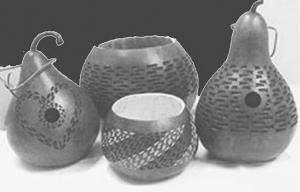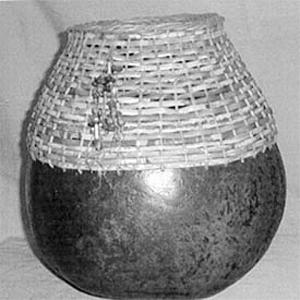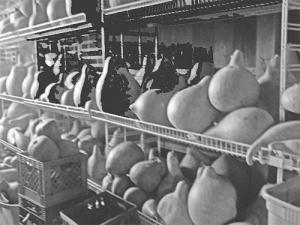2009 - Volume #33, Issue #1, Page #06
[ Sample Stories From This Issue | List of All Stories In This Issue | Print this story
| Read this issue]
Gourd Lady Does Big Business
 |
 |
 |
"I used to look through seed catalogs for unique melons, and then one day I noticed gourds," she recalls. "I thought they might grab attention."
Today she sells gourds to crafts people and artists as well as paints them for fall decorations. Artists, who sell their finished works for as much as $22,000, have used her washed and dried gourds. Other customers make cat houses out of big Bushel gourds and some even make tables.
"One year I painted 7,500 gourds for decorations," she recalls. "Another year, I planted Apple gourds, dried them out and painted them red. One was 6 in. high and 7 in. across. A fellow came up and asked for seed for that apple. He thought they were real."
Large gourd varieties include hard shell Kettle, Bushel, African Kettle, Bottle and Tobacco. She also raises smaller varieties for ornaments and containers, such as Sennari and a smaller version of Bottle. Gourds are available clean or unclean, dried or undried. She sells gourds alone as well as in special packages, such as a box of 25 gourds for $96. She also sells how-to pattern books for use with specific gourds.
Gourds are priced on size, season, quantity and availability. Mini-gourds (2 to 3-in. dia.) can sell for $2 each or $1 each in groups of 25 or more.
Thomas saves seed from her best gourds to ensure uniform genetics from one year to the next. She fertilizes the gourds heavily, similar to melons. Fields can only be left in gourds for two years, with a three-year rotation in alfalfa to build the soil back.
Gourds are picked as soon as the ground frosts. They're piled on wagons or piled on the ground through the winter and spring, as long as six to nine months, until dry.
Gourds are then brought in to a washing area which consists of an 8-ft. dia. cattle tank. Six nozzles on a pipe send water in two directions, powered by a power washer. Each batch of gourds takes about an hour to clean away excess material and get down to the hard shell.
There can be a lot of batches to clean. Yields can reach as high as 150 wagon loads averaging 300 big gourds or 400 small gourds each. However, yields can be much less, and depending on the winter, Thomas can lose half her production due to spoilage.
Once the gourds are washed and dried, they are stored on shelves in her barn. She also uses a house trailer that had been gutted out after a fire and lined with shelves.
Because of the mold that grows on the curing gourds, Thomas advises always wearing protective masks when cutting or working with them. She also suggests using a strong fan when cutting or drilling gourds. "Blow the material away as you cut," she says.
Thomas markets her gourds at area craft markets and from her farm. She also hosts events at the farm. Special gourd craft classes are held there as well as tours of her Museum Collection of Gourd Art. While it doesn't include any $22,000 pieces, the 500-piece collection does include work by many of her customers.
"I have all types of gourd art: tip carving, acrylic, oil, weaving on gourds, even musical instruments made out of gourds," says Thomas. "I have some of the best customers in the world. They're very good artists, and sometimes they will give me a piece or trade one for gourds."
Contact: FARM SHOW Followup, Sandlady's Gourd Farm, 10295 N. 700 W., Tangier, Ind. 47952 (ph 765 498-5428; sandlady@sandlady.com; www.sandlady.com).

Click here to download page story appeared in.

Click here to read entire issue
To read the rest of this story, download this issue below or click here to register with your account number.




